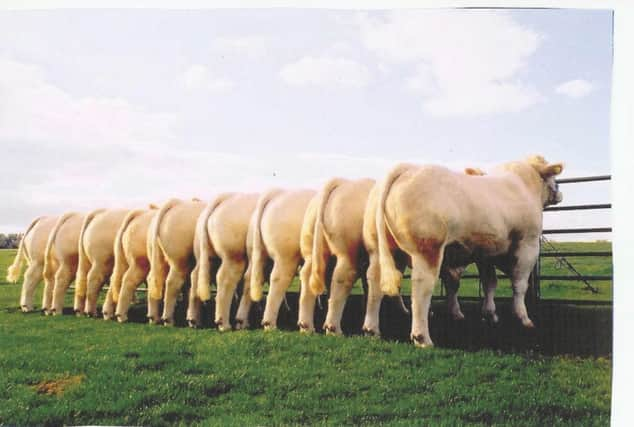Is your bull fit for purpose?


A bull with poor fertility or serving ability can drastically reduce conception rates, and have disastrous effects on calving patterns.
Very few bulls are infertile, but studies have shown that 20% or more of unselected breeding bulls may be classed as subfertile for reasons such as lameness, poor semen quality, penile injuries, among others and therefore fail to perform optimally.
Advertisement
Hide AdAdvertisement
Hide AdA fully fertile bull running with 40-50 females should have the ability to achieve 60% conception rates to each service, meaning at least 94% of cows should be pregnant in nine weeks of breeding. A subfertile bull for example achieving only 40% conception rates to each service will only result in 78% of the cows pregnant in a nine week period. If the mating period is extended to 12 weeks the subfertile bull will only have impregnated 87% of cows compared to 94% in nine weeks for a bull with optimal fertility (Fig 1).
In a dairy herd calving all year round a subfertile bull achieving 40% conceptions rates will result in 22% of the cows barren at 105 days in milk (assuming a voluntary waiting period of 42 days) versus only 6% barren to a fertile bull. This will result in a longer calving interval above target of 365 days and potentially an increased number of cows culled for infertility. As each additional day beyond the 365 days target may cost £2-£3 per cow, using subfertile or infertile bulls may soon lead to a significant financial loss.
How long do bulls last?
A survey of the longevity and reasons for culling in UK beef stock bulls concluded that the average age at culling was 5.8 years and that most bulls are not used until they are at least 18 months old. Therefore most beef bulls only last for about four working years.
Over 30% of bulls were culled due to musculoskeletal problems.
What is the cost of
keeping a bull on farm?
Advertisement
Hide AdAdvertisement
Hide AdMany beef stock bulls sire only around 30-40 calves per year. In Northern Ireland with the average beef suckler herd counting less than 20 cows this number is considerably less on many farms and if an easy calving bull is kept purely for maiden heifers then again this number can be less than 20 calves per year.
The true cost (including fixed and variable costs) of keeping a reasonable quality stock bull on farm may be up to £1600 per year (based on bull purchase price of £4,000 average longevity of four working years).
A reasonable estimate of the cost of each calf produced by natural service is therefore around £45, but could be considerably higher.
Factors that may affect fertility of bulls
Lameness
Poor foot and leg conformation may lead to subsequent problems.
Advertisement
Hide AdAdvertisement
Hide AdSudden diet changes from high concentrate to low forage diets may induce laminitis leading to a lifetime of foot problems and premature culling.
Some bulls may require annual foot trimming which should be done at least two months prior to the start of the breeding season. Many cases of ongoing foot problems could be reduced by genetic selection and less intensive management in the first 18 months of life.
Post-hocked hindleg conformation in young bulls is often associated with increased risk of arthritis.
Bulls should be fit and not fat
Both obesity and very poor body condition will depress fertility.
Advertisement
Hide AdAdvertisement
Hide AdBulls that are overweight due to high energy density rations being fed from weaning to 15 months can suffer temporary subfertility which in most cases will be caused by excessive fat being laid down in the neck of the scrotum.
Obesity puts major pressure on developing bones/joints increasing locomotion problems when bulls are put to work which reduces their herd life.
Penile abnormalities and testicular problems
As some conditions may develop during the breeding period, it is important that bulls are watched to ensure everything is working as it should.
Common penile abnormalities are corkscrew deviation, penile rupture and preputial tearing. Young bulls may develop penile papillomata (commonly known as warts) which may inhibit normal mating.
Advertisement
Hide AdAdvertisement
Hide AdScrotal circumference has been shown to be correlated with sperm output and quality.
Problems such as testicular hypoplasia, degeneration and epididymitis can all affect bull fertility.
Infectious disease
Infections such as BVD virus and Campylobacter could be transmitted to cows during breeding.
How can we identify potentially infertile/subfertile bulls?
Advertisement
Hide AdAdvertisement
Hide AdA Bull Breeding Soundness Examination represents a relatively quick and economical procedure for screening bulls. The examination should be performed routinely on all bulls 30-60 days before the service period to allow enough time for problems to be highlighted.
The procedure consists of:
l A physical examination - looking particularly at conformation and mobility.
l External and internal examination of the genitalia.
l Collection and evaluation of sperm, including detailed microscopic examination for motility, density, live/ dead +normal/ abnormal ratios.